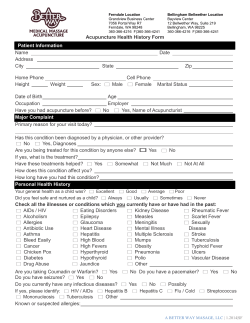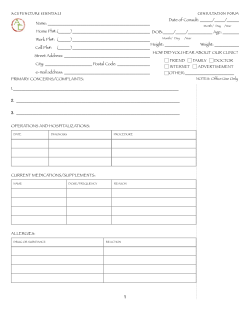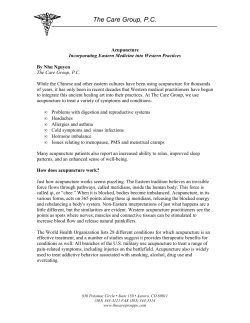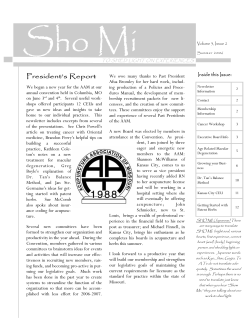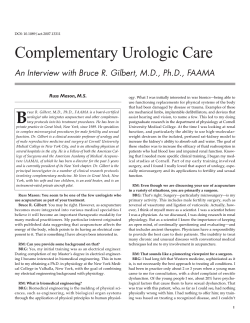
AN INTRODUCTON TO THE DISORDERS BY ACUPUNCTURE
AN INTRODUCTON TO THE TREATMENT OF MALE DISORDERS BY ACUPUNCTURE Studying Chinese medicine (in the West!) Gynaecology •Usually many hours of study. •“Women are complex and interesting”. •“Women get unique female disorders”. So they get extra questions just for them. •“women’s disorders are ten times more difficult to cure than those of males”. Sun Simiao Andrology •Usually zero hours of study. •“Men are simple. It’s just the Kidneys”. •No special question for men. Do we take male problems seriously enough? 1 Men: the stronger sex? •125 males conceived for every 100 females. •105 boys born per 100 girls. •by age sixty-five, 70 male/100 female (Germany), 72/100 (USA). Men: the stronger sex? •Male foetuses more at risk of stillbirth, miscarriage and neonatal death than females. •Boys have higher risk of developmental problems and autism, are more likely to be colour blind, suffer higher rates of hearing loss and (may) have weaker immune systems. •Boys lag behind girls in reading & writing, are more likely to be referred to school psychologist, more likely to have attention deficit disorder (USA, 2005). 2 Men : the weaker sex? • Men die on average five years younger than women. • Men die from just about every disease younger than women (from lung cancer to influenza), e.g. cancer twice as common in men than women. • Men four times more likely to commit suicide than women. • Men drink more alcohol, smoke more, take more risks, suffer more accidental deaths. Male crisis? • Male birth rates are falling, at least in Canada, USA, Sweden, Germany, Norway, Finland. • Almost universal increase in testicular cancer over last 50 years (over last 25 years, in 21 countries, average increase of 60%). • Rapid rise in hypospadias (e.g. doubling in incidence in USA in 1970s and 1980s). • Probable upward trend in cryptorchidism. This can lead to subfertility and raised testicular cancer risk (3.6 times). • Increasing incidence of prostate cancer in most countries (e.g. doubling over the last 20 years in the USA, Canada, France & Asia). The most commonly diagnosed cancer in western men. 3 Possible reasons • 1. Oestrogens from contraceptive pill in water (and taken in pregnancy). • 2. Xeno-oestrogens found in deodorants, skin creams, growth promoters in meat and poultry, plastics, clingfilm, industrial waste, pesticides, herbicides, solvents,detergents, floor polish, paints etc. etc. • 3. Phyto-oestrogens (mainly soya). • 4. Anti-androgens e.g found in shrink-wrap, solvents, pesticides, herbicides, antifungals, industrial pollutants, synthetic chemicals in plastics, foods, drinks and some drugs, cosmetics etc. High levels of phthalates (found in plastics, cosmetics, hairspray, shampoo and soap) in pregnant women correlate directly to malformations of the epididymus, hypospadias, smaller scrotum & penis and greater chance of cryptorchidism. • 5. Some environmental poisons may cause permanent genetic damage. Four main disorders can benefit from acupuncture treatment • 1. Male subfertility • 2. Erectile dysfunction • 3. Benign prostatic hypertrophy (BPH) • 4. Chronic pelvic pain syndrome (CPPS) 4 Male subfertility • Male subfertility may be a factor in 50% to 70% of cases of couple infertility and it is thought this figure is rising. • Up to 50% of male infertility may be unexplained. Falling sperm counts • Significant decline in sperm density in the USA (1.5% a year) and Europe/Australia (3% a year) between 1938 and 1990. • Aberdeen study 1989 - 2002 (13 years) of 7,500 men with 20 million + sperm per ml). Average sperm count fell from 87m sperm per ml to 62m = Decline of 29%. • Additional theories: increasing age of fathers, increasing obesity, rising diabetes, disposable nappies, laptops, mobile phones etc. • The number of men seeking treatment for fertility problems in Merseyside and Cheshire has increased by nearly 70% in the past four years. 5 Assisted reproduction Three main kinds: • Intrauterine insemination (IUI). For mild subfertility (needs 3-5 million progressively motile sperm), male or female antisperm antibodies, retrograde or premature ejaculation. • In-vitro fertilisation (IVF). Needs 0.5m sperm per cycle. Increasingly replaced by ICSI. • Intracytoplasmic Sperm Injection (ICSI). Injection of a single sperm into a mature egg. Egg can be taken from ejaculate, from the epididymis or seminiferous tubules, irrespective of condition of sperm or cause of infertility. “No sperm defect precludes success with ICSI” Assisted reproduction: downside • Meta-analysis (of 25 studies) suggests a statistically significant 30-40% increased risk of birth defects associated with ART. (Hansen et. al. 2005). • Single study (Hansen et. al. 2002) showed around 9% (after correction for multiple births, maternal age & parity) of ART babies had birth defect compared to 4.5% of natural births. • ART associated with 30-50% of twin births and up to 80% of higher order multiple births (triplets, quads etc.). • Significant reduction in testosterone of boys conceived by ICSI. 6 Erectile dysfunction/impotence Definition: “The inability to develop and maintain an erection for satisfactory sexual intercourse or activity”. • The Massachusetts Male Aging Study: All degrees of impotence: 52% (minimal: 17.2%, moderate: 25.5%, complete: 9.6%). • Rises steadily with age (affects 66% of over 70s). • Israeli Defence Force: 5836 men aged 25-50: 26.9% (19% mild, 7% moderate, 1% severe). Erectile dysfunction • Previously thought that most was psychogenic. • Now: thought at least 70% is organic. • Psychogenic causes predominate in younger men (70% of cases found in under 35s). • Organic causes predominate in older men (85% of cases found in over 50s). 7 Erectile dysfunction “Most people who have a physical cause for their impotence have a disease entity that is causing the impotence, so you have patients out there with undiagnosed diabetes, vascular problems and heart disease whose first sign of a problem is impotence. In fact, one-third of all patients who present as impotence as their primary symptom of a blood vessel problem will end up with a serious complication within three years, either a heart attack or a stroke”. Erectile dysfunction • All men over the age of 25 should be asked about ED and assessed for cardiovascular disease if they have symptoms of erectile dysfunction. • Atherosclerosis found in approximately 40% of ED in men older than 50 years, and is associated with hypertension, lipid problems (cholesterol, triglycerides), diabetes and cigarette smoking. • Around half of all diabetic men suffer from erectile dysfunction and amongst diabetics erectile dysfunction is also an especially important indicator of cardiovascular disease, diabetic men with erectile dysfunction having an eightfold risk of undiagnosed heart disease. 8 Erectile dysfunction • ED may also be a presenting symptom in … stroke, Parkinson’s disease, multiple sclerosis, Alzheimer’s disease, sleep apnoea, chronic obstructive pulmonary disease, chronic renal failure, hepatic failure, thyroid disorders, low testosterone and other hormonal disorders and herniated lumbar disc, and may follow pelvic trauma, pelvic surgery or pelvic radiotherapy. Erectile dysfunction • Depression: Half of all men with ED are depressed. • Depression significantly reduces with successful treatment of ED. As does low self-esteem/selfconfidence/relationship satisfaction. 9 Benign prostatic hypertrophy (BPH) Benign prostatic hypertrophy (BPH) • More than half of men in their sixties and as many as 80% in their seventies and eighties have some symptoms of BPH. Between 20 to 30 percent of men will need medical or surgical treatment of BPH before they reach age 80. • Increasing life expectancy means more & more men suffering symptoms. 10 BPH symptoms • • • • • • • • • • progressive urinary frequency urgent urination nocturia hesitant and intermittent flow, difficult urination weak urinary flow terminal dribbling feeling of incomplete emptying severely complete urinary retention sometimes blood in the urine BPH, and especially residual urine, makes men prone to urinary infections, kidney stones and prostatitis Is it BPH? • So, the main presentation is lower urinary tract symptoms (LUTS). • But … BPH can be asymptomatic and at least 25% of men with LUTS do not have BPH and symptoms are directly due to bladder dysfunction. • Successful treatment does not therefore always rely on shrinking the prostate. 11 Chronic pelvic pain syndrome (CPPS) Classification of prostatitis (the most common urologic problem in men under 50) 1. Acute bacterial prostatitis. 2. Chronic bacterial prostatitis. 3. Chronic abacterial prostatitis/chronic pelvic pain syndrome (CPPS) - subdivided into inflammatory & non-inflammatory. 4. Asymptomatic inflammatory prostatitis. Chronic pelvic pain syndrome (CPPS) • Also still known as chronic prostatitis although not associated with demonstrable infection. • Incidence is recorded as varying between 3% of men and 15%. • Estimated that half of men will experience symptoms in their lifetime. 12 CPPS symptoms • • • • • • pain or discomfort in the pelvic region or thereabouts lasting three months or more that is typically episodic, located in the: perineum (most common site) deep anus (2nd most common) low back (3rd most common) also tip of the penis (not related to urination), urethra, pubic or bladder area, testicles. May (or may not) also be: burning/painful urination, pain during or after ejaculation, lowered libido, extreme fatigue, discoloured (yellowish) seminal fluid, impaired memory, difficult concentration, painful lymph nodes. CPPS • "The quality of life for a patient with Chronic Prostatitis is similar to that experienced by patients with acute myocardial infarction, unstable angina or active Crohn disease". J. Curtis Nickel, MD, FRCSC, Canada. • "Some patients experience so much pain that the condition is handled much like a chronic pain syndrome that occurs secondary to cancer. Therapy may begin with judicious use of narcotics until the patient experiences some relief". Keith B. Armitage, MD et al. 13 What can acupuncture offer in these 4 diseases? • Male subfertility. There is growing evidence that acupuncture can promote the number of sperm and enhance sperm motility and morphology. It may also improve sperm defragmentation. Therefore acupuncture may improve the chances of natural conception and of assisted reproduction techniques. • Erectile dysfunction. There is some Western (and copious Chinese) evidence that acupuncture can improve ED, especially psychogenic. • BPH and chronic pelvic pain syndrome (CPPS). There is limited Western and copious Chinese evidence that acupuncture can improve symptoms of both these disorders. The primary zangfu involved in male disorders: the Kidneys • The Kidneys store essence (jing) and are the root of sexual development, libido and fertility and control the urethra and testicles (“wai shen” = external Kidneys). • “At the age of 16, the Kidney qi of a man becomes even more abundant, his sexual function begins to develop, and he is filled with semen that he can ejaculate. When he has sexual intercourse with a woman, she can have children”. • Hence the seminal fluid and male fertility is originally governed by the Kidneys. • The Kidneys can only be deficient: yang, yin, qi and essence. 14 Kidney patterns • Kidney yang • Warms the ‘bao’ (the room of sperm) in the lower abdomen (= zi bao/uterus in females). Without Kidney yang, the bao will be cold and there may be : Impaired fertility, low libido, erectile dysfunction, lack of morning or night-time erection, coldness of the genitals, coldness and/or aching of the lower back/limbs/feet, thin and watery seminal fluid, frequent urination, weak-stream urination, dull pain on urination, dribbling urination etc. Kidney patterns Kidney yin • Deficiency of Kidney yin may impair fluids (hence low volume of seminal fluid) and give rise to unanchored/deficiency heat with heightened libido (maybe with impaired erection), premature ejaculation, spermatorrhoea, feeling hot at night, hot feet, impaired fertility, urinary frequency/irritability/dribbling with yellow urine, bloody urine etc. 15 Kidney patterns Kidney essence (jing) • If congenitally deficient may be associated with poor development of secondary sexual characteristics, undeveloped testicles, lifetime disinterest in sex etc. • If acquired (‘post-heaven’) deficiency, may be associated with premature ageing. • Both may give rise to impaired infertility, low libido, erectile dysfunction. The primary zangfu involved in male disorders: the Liver • The Liver governs the sinews and the penis is known as the ‘zong jin’ = “meeting of the ancestral/one hundred sinews”. • The slow/deep root of Liver fire is Kidney yang (ming men fire) but it is Liver fire that can suddenly arouse the zong jin. • The free-going function of the Liver ensures the free and unobstructed circulation of qi and blood to the pelvis and genital region. 16 Liver patterns • Deficiency • The close relationship between Liver blood and Kidney essence means that deficiency of Liver blood may manifest as deficiency of essence (hence impaired fertility), and ED (inability to maintain an erection). Liver patterns Excess 1: Stagnation of Liver qi/ blood stasis Gives rise to: 17 Liver patterns Excess 2: Liver channel damp-heat Gives rise to: The primary zangfu involved in male disorders: the Spleen 1. Spleen deficiency • The Spleen is ‘later heaven’ and thus the main source of postnatal essence. • Spleen deficiency can fail to nourish Kidneys and both Kidney yin and Kidney yang can become deficient. • In a patient who is pale, with poor appetite, loose stools, weak muscles etc. tonify Spleen to support Kidney tonifying or other treatment. 18 Spleen patterns 2. Spleen deficiency leads to excess The secondary zangfu involved in male disorders: the Gall Bladder & Heart •Gall Bladder (& Heart) deficiency associated with timidity & cowardice, sexual anxiety, disengaged sexuality. •Accompanied by palpitations, insomnia, anxiety, excessive dreaming, sensitivity to being startled or being easily frightened, and depression. 19 The Heart (mainly ED) Chen Shiduo(17th C) •“When men get depressed and gloomy due to dissatisfaction with their lives and accomplishments, it may lead to depression and anxiety, and erectile deficiency or weak erection ensues.” • “When men engage in sex with women, suddenly they may experience failure of erection. Though they try to invigorate themselves with hundreds of methods, none works. This situation is usually thought of as lassitude of the fire of the life gate”. •“As soon as Heart fire (the emperor) has been aroused, the Kidney (its minister) will follow. if the emperor is too weak, no matter how hard the minister urges the emperor (Heart fire) onwards, the emperor still cannot become aroused” Other patterns: blood stasis •Tends to be a complication of other patterns. •Can result from cold, prolonged qi stagnation, qi deficiency (including the deficiency of old age), prolonged obstruction by dampness, phlegm and/or heat, lack of exercise and excessive sitting, traumatic injury, surgery and invasive medical procedures. 20 The channels: the Liver The Liver primary channel encircles the genitals The Liver Luoconnecting channel ascends to the genitals The channels: the Liver The Liver divergent channel connects with the Gall Bladder primary channel at the pubic region The Liver sinew channel ascends to the the genitals 21 The channels: the Conception & Governing vessels The Governing vessel first branch originates in the lower abdomen and descends to the genitals The Conception vessel arises in the lower Abdomen in men and ascends through the genitals The channels: the Spleen & Kidney channels The Spleen sinew channel converges at the genitals. The Kidney sinew channel joins with the Spleen sinew channel on the thigh and binds at the genitals 22 Asking diagnosis Ask about Libido, erectile function, frequency of coitus, ejaculation, any history of previous pregnancies with the same or other partners, STDs, infections, discharge, urinary diseases, fevers, scrotal diseases, pain, lumps, localised skin diseases, lifestyle (including alcohol, recreational drugs, smoking, exercise) Asking diagnosis: how • Start with pelvic pain. Explain that a lot of men experience some kind of pelvic pain - independent of bowel function - associated/not associated with sexual activity. • Ask open-ended question about sexual activity e.g. “How would you rate your sexual satisfaction from 1 to 10”? If less than 10, ask “What would need to be different to bring it to a 10”. 23 Asking diagnosis: how • Explain that erectile function is a good indicator of general health and underlying disease. • Remember that libido & erectile function are not the same. • Ask about ejaculate (discolouration) and discharge, explaining that they are also useful indicators of health. • Poor erectile function, when brought into the open, can be a good opening to suggesting lifestyle changes, e.g. stopping smoking and excess alcohol and starting to exercise can all improve erectile function. TREATMENT Some important acupuncture points for treating male diseases 24 Main points: Ciliao BL-32 Location Over the second posterior sacral foramen. Needling Perpendicular insertion 0.5 to 1 cun, or 1.5 to 2 cun through the foramen. Needling through the foramen is facilitated by a slightly oblique medial and inferior insertion. Main points: Huiyang BL-35 Location 0.5 cun lateral to the Governing vessel, level with the tip of the coccyx. Needling Perpendicular insertion 1 to 1.5 cun. Note Can be needled up to 3 cun deep. Deqi can radiate to perineum or genital region. Actions Clears damp-heat and regulates the lower jiao 25 Main points: Guanyuan REN-4 Meeting point of the Conception vessel with the Spleen, Liver and Kidney channels Location On the midline of the lower abdomen, 3 cun inferior to the umbilicus and 2 cun superior to the pubic symphysis. Actions Fortifies the original qi and benefits essence Tonifies and nourishes the Kidneys Warms and fortifies the Spleen Needling Perpendicular insertion 0.5 to 1 cun, or oblique insertion directed inferiorly, 1 to 1.5 cun. Caution: deep insertion may penetrate a full bladder which should therefore be emptied before treatment. Main points: Qichong ST-30 Location On the lower abdomen, 2 cun lateral to the midline, level with the superior border of the pubic symphysis (Qugu REN-2). Needling Perpendicular insertion 1 to 1.5 cun. Caution: in thin patients, i. deep insertion in a superior direction may penetrate the peritoneal cavity or a full bladder (the patient should therefore be asked to empty the bladder before needling); ii. deep insertion in an inferior direction in the male may penetrate the spermatic cord. 26 Main points: Zhibian BL-54 Location On the buttock, in the depression 3 cun lateral to the sacro-coccygeal hiatus. Needling Three to five cun deep in the direction of Shuidao ST-28 in the treatment of BPH and CPPS. Main points: Sanyinjiao SP-6 Location On the medial side of the lower leg, 3 cun superior to the prominence of the medial malleolus, in a depression close to the medial crest of the tibia. Actions Tonifies and regulates the three main zang associated with male disorders: the Spleen, Liver and Kidney. 27 Secondary points • To tonify and regulate the Kidneys: Shenshu BL-23, Guanyuan REN-4, Zhongji REN-3, Taixi KID-3, Henggu KID-11, Dahe KID-12, Rangu KID-2. • To move blood and qi stagnation: Sanyinjiao SP-6, Diji SP8, Dadun LIV-1, Taichong LIV-3. • To warm the lower jiao: Guilai ST-29 • To drain damp and damp-heat: Pangguangshu BL-28, Zhongji REN-3, Yingu KID-10, Ququan LIV-8, Ligou LIV-5, Jiaoxin KID-8. What can Chinese health preservation offer? The principal pathology of male disorders is: • 1. Kidney deficiency • 2. Stagnation of qi and/or blood • Sinking of damp, damp-heat or phlegm. • Conservation of essence by moderate and regular lifestyle and strengthening of the body, especially the pelvic floor, back, feet and legs, can help fortify the Kidneys. 28 What can Chinese health preservation offer? • Exercise can strengthen the Spleen and promote free flow of qi and blood. Exercise is known to reduce risk of erectile dysfunction (ED), prostate enlargement (BPH) and prostate cancer. Pelvic floor exercises can dramatically improve ED and some male urinary disorders. • A balanced and healthy diet can reduce the formation of dampness and phlegm. Obesity is known to increase the risk of male subfertility and ED. Possibly also prostate disorders. • Smoking and excessive alcohol intake can increase the risk of all male disorders. What can Chinese health preservation offer? • Cultivation of the mind and emotions emotional intelligence - may help prevent stagnation of Liver qi - an important aetiology in male disorders. 29 Research • • • • Quantitative evaluation of spermatozoa ultrastructure after acupuncture treatment for idiopathic male infertility Jian Pei, Erwin Strehler, Ulrich Noss, Markus Abt, Paola Piomboni, Baccio Baccetti and Karl Sterzik. Fertility and Sterility, vol. 84, issue 1, July 2005, pp141-147). Effects of acupuncture and moxa treatment in patients with semen abnormalities Gurfinkel E, Cedenho AP, Yamamura Y, Srougi M. Asian J Androl. 2003 Dec;5(4):345-8. Does acupuncture treatment affect sperm density in males with very low sperm count? A pilot study Siterman S, Eltes F, Wolfson V, Lederman H, Bartoov B. Andrologia. 2000 Jan;32(1):31-9. Influence of acupuncture on idiopathic male infertility in assisted reproductive technology. Zhang M, Huang G, Lu F, Paulus WE, Sterzik K. J Huanzhong Univ Sci Technolog Med Sci 2002;22(3):228-30. Research • • • • Effect of acupuncture on sperm parameters of males suffering from subfertility related to low sperm quality Siterman S, Eltes F, Wolfson V, Zabludovsky N, Bartoov B. Arch Androl. 1997 Sep-Oct;39(2):155-61. The use of acupuncture in the treatment of erectile dysfunction Int J Impot Res. 1999 Feb; 11, 41-46. H G Kho, C G J Sweep, X Chen, P R I Rabsztyn and E J H Meuleman Acupuncture in the t reatm ent of psychogenic erectile dysfunction: first results of a prospective randomized placebo-controlled study. Engelhardt PF, Daha LK, Zils T, Simak R, Konig K, Pfluger H. Int J Impot Res. 2003 Oct;15(5):343-6. Acupuncture for chronic prostatitis/chronic pelvic pain syndrome. Chen RC, Nickel JC. Current Urology Reports 5 (4): 305-8, Aug 2004. 30 Research Quantitative evaluation of spermatozoa ultrastructure after acupuncture treatment for idiopathic male infertility Jian Pei, Erwin Strehler, Ulrich Noss, Markus Abt, Paola Piomboni, Baccio Baccetti and Karl Sterzik. Fertility and Sterility, vol. 84, issue 1, July 2005, pp141-147). • 40 German men with idiopathic oligospermia (too few sperm), asthenospermia (poor motility) or teratozoospermia (poor morphology). • 28 received acupuncture twice a week for 5 weeks. Compared to 12 in the untreated control group. • After treatment there was a significant improvement in the percentage and number of normal morphology sperm (particularly head and midpiece of tail. Also improvement in total motility (from 44.5% to 50%). • Main points: Guanyuan REN-4, Shenshu BL-23, Ciliao BL-32, Taichong LIV-3, Taixi KID-3. Secondary points: Zusanli ST-36, Xuehai SP-10, Sanyinjiao SP-6, Guilai ST-29, Baihui DU-20. Deqi obtained. Needling sensation from Shenshu BL-23 and Ciliao BL-32 transmitted to sacral or perineal areas. Further manipulation after 10 minutes. Retained 25 minutes. Conclusion: The treatment of idiopathic male infertility could benefit from employing acupuncture. A general improvement of sperm quality, specifically in the ultrastructural integrity of spermatozoa, was seen after acupuncture, although we did not identify specific sperm pathologies that could be particularly sensitive to this therapy. Research Effects of acupuncture and moxa treatment in patients with semen abnormalities Gurfinkel E, Cedenho AP, Yamamura Y, Srougi M. (Asian J Androl. 2003 Dec;5(4):345-8.) • Prospective, controlled, blind study. • 19 men with idiopathic oligospermia, asthenospermia or teratozoospermia randomised into two groups. Both groups given acupuncture and moxibustion, the treatment group at ‘therapeutic’ points and the control group at ‘indifferent’ points. • Treatment lasted ten weeks (25 mins of acupuncture and 20 mins of moxibustion, twice a week). Deqi obtained. • After treatment significant increase in % of normal-form sperm in treatment group compared to control. Acupuncture points: Qichong ST-30, Taixi KID-3, Zusanli ST-36, Hegu L.I.-4, Sanyinjiao SP-6, Gongsun SP-4, Taichong LIV-3, Neiguan P-6. Moxa Points Shenshu BL-23, Qihai REN-6, Shimen REN-5, Qimen LIV-14 (?), Zhishi BL-52, Guanyuan REN-4, Taiyuan LU-9, Zigong (M-CA-18), Sanjiaoshu BL-22, Zhongji REN-3, Feishu BL-13, Mingmen DU-4, Pishu BL-20, Jueyinshu BL-14, Ciliao BL-32, Weishu BL-21, Xinshu BL-15. 31 Research Does acupuncture treatment affect sperm density in males with very low sperm count? A pilot study Siterman S, Eltes F, Wolfson V, Lederman H, Bartoov B. (Andrologia. 2000 Jan;32(1):31-9.) • 20 patients with history of azoospermia (all diagnosed by at least 3 consecutive light miscorscope exams, 3 months apart). • Further microscopic examination at Bar-Ilan Uninv. revealed 3 severely oligoteratoasthenozoospermic (between 0.5 and 1.8m per ejaculate), and 17 azoospermic. • Control group (20) with comparable sperm profiles. • Treatments given twice a week for 5 weeks. Deqi obtained, retained 25 mins. • Main points: Sanyinjiao SP-6, Guanyuan REN-4, Lieque LU-7, Zhaohai KID-6, Qichong ST-30. • For Kidney yang deficiency: Taixi KID-3, Shenshu BL-23, Henggu KID-11, Zhishi BL-52. Reinforced. • For for damp-heat: Yinlingquan SP-9, Ligou LIV-5, Quchi L.I.-11, Shuidao ST-28, Zulinqi GB-41. Reduced. • 15 other secondary points were also used. • 13 of 20 exhibited a considerable improvement in sperm density following treatment. • Males with genital tract inflammation exhibited the most remarkable improvement in sperm density Research Influence of acupuncture on idiopathic male infertility in assisted reproductive technology. J Huanzhong Univ Sci Technolog Med Sci 2002;22(3):228-30. Zhang M, Huang G, Lu F, Paulus WE, Sterzik K. • 22 patients who failed in intracytoplasmic sperm injection (ICSI) with idiopathic male infertility were treated with acupuncture twice weekly for 8 weeks, followed by ICSI treatment again. • The sperm concentration, motility, morphology, fertilization rates and embryo quality were observed. Sperm motility after acupuncture was significantly improved as compared with that before treatment. The normal sperm ratio was increased after acupuncture. The fertilization rates after acupuncture (66.2%) were obviously higher than that before treatment (40.2%, P < 0.01). There was no significant difference in sperm concentration and general sperm motility between before and after acupuncture. The embryo quality after acupuncture was improved, but the difference between them was not significant (P > 0.05). • Acupuncture can improve sperm quality and fertilization rates in assisted reproductive technology. 32 Research Effect of acupuncture on sperm parameters of males suffering from subfertility related to low sperm quality Arch Androl. 1997 Sep-Oct;39(2):155-61.) Siterman S, Eltes F, Wolfson V, Zabludovsky N, Bartoov B. • Semen samples of 16 acupuncture-treated subfertile patients were analyzed before and 1 month after treatment (twice a week for 5 weeks). In parallel, semen samples of 16 control untreated subfertile males were examined. Two specimens were taken from the control group at an interval of 2-8 months. The expanded semen analysis included routine and ultramorphological observations. • The fertility index increased significantly (p < or = .05) following improvement in total functional sperm fraction, percentage of viability, total motile spermatozoa per ejaculate, and integrity of the axonema (p < or = .05), which occurred upon treatment. • The intactness of axonema and sperm motility were highly correlated (corr. = .50, p < or = .05). • Thus, patients exhibiting a low fertility potential due to reduced sperm activity may benefit from acupuncture treatment. 33
© Copyright 2025

